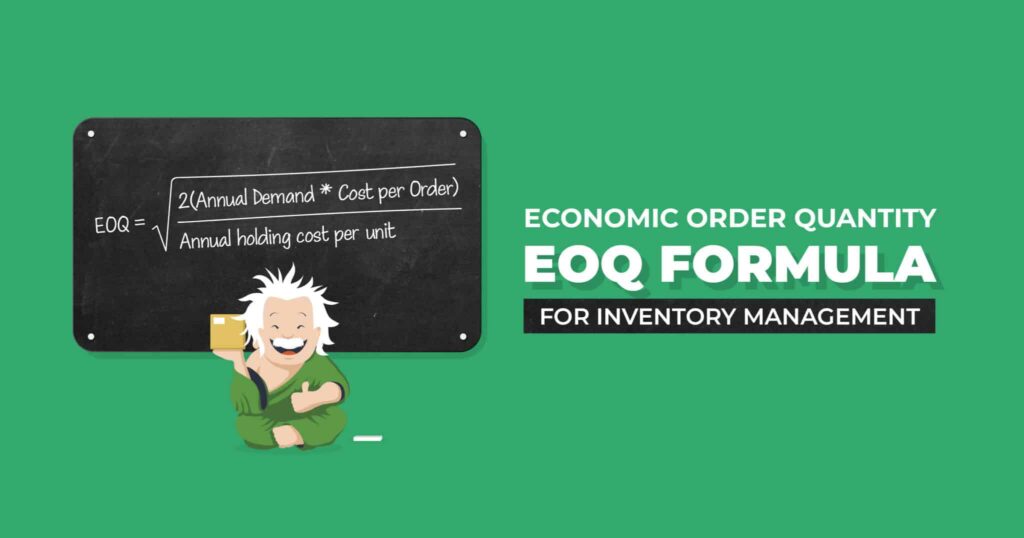Learning how to manage inventory is one of the biggest challenges of owning an eCommerce business. It’s not for lack of information on the subject, either. There are many different models for forecasting inventory, and plenty of textbooks written on the subject.
Most of these methods rely on past sales data, future forecasting, or a combination of the two to help inventory managers predict how much inventory they’ll need. The biggest drawback of these methods is that they don’t take into account the total costs of placing an order, such as setup costs and storage costs.
But let’s get real. You didn’t major in economics. Let’s say your eCommerce business makes cotton baby blankets. You tend to order more whenever you start running low, and take an educated guess about how many you’ll need to get through the next sales period. But what if you could lower your cost per blanket simply by tweaking the frequency and quantity of your orders? Well, there’s a formula for figuring that out! It’s called the EOQ formula.
What Does EOQ Stand for? How Can it Help Me Reduce Cost and Help Me Save?
EOQ stands for Economic Order Quantity. The EOQ formula calculates the ideal quantity of inventory to order from your manufacturer to avoid stockouts and overstocks, while also minimizing storage and setup costs. Many companies use the EOQ model to manage inventory more efficiently while simultaneously minimizing inventory costs.
What is the EOQ Formula?
To calculate EOQ you’ll need to know your setup costs, demand rate, and holding costs (sometimes referred to as carrying costs). You probably know your demand rate off the top of your head, or can quickly find it. It’s simply how many blankets you sold last year. Setup costs and holding costs are a little more difficult to calculate.
How to Calculate Setup Costs
Your setup costs include all costs incurred to ship a year’s worth of blankets to the warehouse and get them on the shelf, ready for fulfillment. This includes packaging, labor, shipping and handling, as well as receiving and setup at the warehouse. If you outsource fulfillment, your 3PL should be able to help you with their portion of this number.
How to Calculate Holding Costs
Holding costs or carrying costs are all costs incurred for keeping one blanket on a shelf in the warehouse for a full year. It is usually expressed as a percentage. Holding costs include warehousing and logistics costs, insurance, opportunity costs, and depreciation costs. Opportunity costs are the costs you incurred to place the order, or cash spent which could’ve been used for other purposes. Depending on your product, you may or may not have depreciation costs, but you will likely have some write-offs for damaged or lost inventory and slow moving items.
The basic formula for calculating holding costs is:
Holding Costs = Storage & logistics costs + opportunity costs + depreciation costs
Total value of one year’s worth of inventory
Let’s See How EOQ Works in Action
Once you have the figures for setup costs, holding costs and demand rate, you can plug those numbers into the formula above to arrive at the optimal order size for minimizing inventory costs for a particular item, such as a baby blanket.
First Calculate Your Holding Cost
Let’s say your company sells 24,000 baby blankets per year for $30 each. The value of a year’s worth of inventory is therefore $720,000. Your shipping and labor costs to get 24,000 blankets to the fulfillment center and on the shelves is $3,000. The cost to store and insure them per year is $4,000. Your cost of goods sold is $8 per blanket or $192,000. (That becomes your opportunity cost.)
Storage, setup and opportunity costs are 3,000 + $4,000 + $192,000 = $199,000.
Your holding cost is calculated as follows: $199,000 / $720,000 = 27.64%.
$30 per blanket x 27.64% = $8.29 holding cost per blanket
Now Let’s Calculate Your EOQ
Using the example of the baby blanket business above, where demand rate is 24,000, setup costs are $7,000 ($3,000 + $4,000), and holding cost per blanket is $8.29, we can calculate the EOQ as follows:
The square root of ((2 x $7,000 x 24,000) / $8.29) = EOQ of 6,366 blankets per order.
For this eCommerce company, placing 4 orders per year (i.e. 24,000 units forecast / 6366 blankers per order = 3.77 orders) makes the most economic sense.
Obviously, this is an extremely simplified example. Your numbers will vary greatly depending on your 3PL’s pricing structure and fees, the size and weight of your product, perishable vs. non-perishable products, freight distance, and seasonality. For example, if 80% of your business is in November, you may want to calculate EOQ quarterly.
How to Use EOQ to Minimize Inventory Costs and Save Money
If your inventory manager is constantly reacting to shortages by ordering small batches of inventory, you may be paying too much in setup costs. On the other hand, if you are placing large orders that will be stored for long periods of time, you may be paying too much in holding costs. Calculating the EOQ helps you balance these budgets to improve cash flow. The formula factors in timing to show you how often and how much of each unit to order so you can meet customer demand and minimize costs over a specific time period.
For some companies, small orders may be more efficient, while for others large orders reduce costs. You won’t know which works best for your eCommerce business until you do the math. Cheers to improved efficiency and fewer days of dusty shelved SKUs silently eating up your cash reserves!
What about Seasonal Sales Peaks?
The Economic Order Quantity formula is not the be-all and end-all of inventory management. For one thing, it assumes that costs and demand for your product remain relatively constant over time. Sudden surges in demand during peak season, or increases in supply chain costs such as those associated with the recent pandemic, will force you to recalculate EOQ. Still, when used with other models for managing inventory, EOQ is a useful tool for reducing inventory costs and improving cash flow.
Reorder Points
EOQ can also be used to establish reorder points. If you have an inventory management system, or your 3PL incorporates IMS technology, you can automate inventory orders for certain times of the year.
Safety Stock
Calculating EOQ will show you the minimum quantity of stock to reorder to reduce costs. For fast-moving items, however, you may want to keep extra stock on hand called “safety stock” to cover unexpected surges in demand, supply chain issues, or peak sales periods. This can prevent one of many common peak season mishaps.
Inventory Tracking
Some fulfillment centers’ warehouse management systems are more robust than others. These systems track inventory in real time so you can see exactly how much you have on hand at any given moment, receive alerts, and place orders faster.
Used in connection with other inventory management tools, the Economic Order Quantity model gives eCommerce businesses a different perspective from which to evaluate ordering practices. By bringing all the costs associated with inventory storage, space, and logistics into the calculations, it takes some of the guesswork out of reordering. Instinct and market knowledge will still carry some weight in your calculations, but EOQ will give you a starting point to make more cost-effective inventory management decisions.
ShipMonk’s industry leading software platform puts the information you need to calculate EOQ, monitor and control inventory levels, and track orders in real time. Contact us and demo ShipMonk’s fulfillment platform today!





